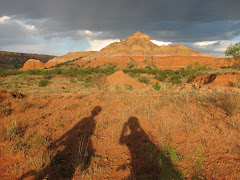After breakfast we are shuttled to the docks, and board a tour boat.

 A guide sits at the front with a microphone, and is loaded with information - in english and spanish. The first stop is at one of the floating islands of the Uros people. The Uros live on about 40 self-made floating islands, fashioned from totora reeds, which grow all around the shallows of Lake Titicaca. There are about 2000 Uros left, but only a few hundred still live on the reed islands. We visit one of their islands, where they have all sorts of handicrafts out for us to buy, including mobiles made from the totora reeds. They use this plant for everything. They give us a short demonstration of how they build their islands, translated by our guide, as they speak mainly Aymara. We get about a half-hour ride in
A guide sits at the front with a microphone, and is loaded with information - in english and spanish. The first stop is at one of the floating islands of the Uros people. The Uros live on about 40 self-made floating islands, fashioned from totora reeds, which grow all around the shallows of Lake Titicaca. There are about 2000 Uros left, but only a few hundred still live on the reed islands. We visit one of their islands, where they have all sorts of handicrafts out for us to buy, including mobiles made from the totora reeds. They use this plant for everything. They give us a short demonstration of how they build their islands, translated by our guide, as they speak mainly Aymara. We get about a half-hour ride in
 a traditional boat made of reeds. They stopped using these boats a few years ago, upgrading to modern boats, some even with - gasp! - MOTORS. They keep one or two of the boats around though, for us turistas. From here it is on to the island of Taquile.
a traditional boat made of reeds. They stopped using these boats a few years ago, upgrading to modern boats, some even with - gasp! - MOTORS. They keep one or two of the boats around though, for us turistas. From here it is on to the island of Taquile. 
Taquile is a 5.7 square kilometer island about 45 km from Puno. Its population is about 1700, and the people have a culture all their own. The island is like a small mountain. We take a beautiful hike winding up from the docks
 toward the top of the island, where we will have lunch prepared in one of a number of restaurants. The hike winds through homesteads, pastures and farmland. At the top of the hike is a plaza, with - surprise! - a shop where you can buy crafts. Taquile is known for its fine handwoven crafts, regarded as some of the finest in Peru. We buy more stuff.
toward the top of the island, where we will have lunch prepared in one of a number of restaurants. The hike winds through homesteads, pastures and farmland. At the top of the hike is a plaza, with - surprise! - a shop where you can buy crafts. Taquile is known for its fine handwoven crafts, regarded as some of the finest in Peru. We buy more stuff. 
Lunch is excellent trout, with a beautiful open-air view out over the Lake from whence it came. And there is also a demonstration of the local music and dance.

We hike down to the boat for the long ride back to Puno. On the way back, we chat personally with the guide about his life, and he asks about ours. This was nice.
As we near the docks, the guide is on his phone for a bit, when he finishes, he informs us that in a couple of days, on the 17th, there will be a protest for the Bagua people in a town between Puno and Cusco, and no trains or automobiles will be allowed through. Thus begins "Transportation Adventure #1". For months we've had a train booked to Cusco on this day, and there aren't any other trains scheduled on the days immediately before or after. Also, my sister joins us in Cusco on the 18th, the next day! We start scrambling to figure out how to get to Cusco. We have the bus from the docks drop us at the train station, and the station agent verifies that there is a distinct possibility that the train will not run. He is supposed to call our hotel tomorrow morning to let us know.
We head back to the hotel, shower, and head to a restaurant that Yolanda recommends for its food, traditional music, and dance, Balconies de Puno. It is the warmest place we've been in days. As we are waiting for our food the band sets up and begins, and they are excellent. Two guys play nylon string guitars, with another on the Charango, an andean instrument with 5 pairs of strings, similar to a Ukelele. There are 2 guys that alternate on wind instruments, between the Quena (a tubular wooden flute) and various wooden pan-flute type instruments, such as the Siku and the Antara. One guy plays a Wancara, a large, bassy skin drum. All of them sing.
About the time we get our food, the dancers start. There are generally 2 females and 2 males, in the small space in front of the band, which is basically right in front of our table. They are decked out in traditional costumes, and they are fantastic. They dance for a song, then disappear to another room somewhere.


The band plays another tune without them, and then they emerge once again, in completely different but still elaborate costumes, and do another traditional dance for a song. This pattern continues for over an hour, at which point they've come out at least 12 times, always in new costumes. It is an incredible show!

No comments:
Post a Comment